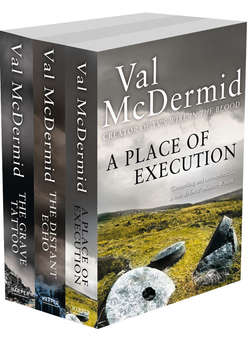Читать книгу Val McDermid 3-Book Crime Collection: A Place of Execution, The Distant Echo, The Grave Tattoo - Val McDermid, Val McDermid - Страница 12
Introduction
ОглавлениеLike Alison Carter, I was born in Derbyshire in 1950. Like her, I grew up familiar with the limestone dales of the White Peak, no stranger to the winter blizzards that regularly cut us off from the rest of the country. It was in Buxton, after all, that snow once stopped play in a county cricket match in June.
So when Alison Carter went missing in December 1963, it meant more to me and my classmates than it can have done to most other people. We knew villages like the one she’d grown up in. We knew the sort of things she’d have done every day. We suffered through similar classes and cloakroom arguments about which of the Fab Four was our favourite Beatle. We imagined we shared the same hopes, dreams and fears. Because of that, right from the word go, we all knew something terrible had happened to Alison Carter, because something we also knew was that girls like her – like us – didn’t run away. Not in Derbyshire in the middle of December, anyway.
It wasn’t just the thirteen-year-old girls who understood that. My father was one of the hundreds of volunteer searchers who combed the high moorland and the wooded valleys around Scardale, and his grim face when he returned home after a fruitless day scouring the landscape is still sharply etched in my memory.
We followed the hunt for Alison Carter in the newspapers, and every day at school for weeks, someone would be bound to start the speculation rolling. All these years later, I still had more questions for George Bennett than the former policeman could answer.
I have not based my narrative solely on George Bennett’s contemporaneous notes and current memories. While researching this book, I made several visits to Scardale and the surrounding area, interviewing many of the people who played a part in the unfolding of Alison Carter’s story, gathering their impressions, comparing their accounts of events as they experienced them. I could not have completed this book without the help of Janet Carter, Tommy Clough, Peter Grundy, Charles Lomas, Kathy Lomas and Don Smart. I have taken some artistic licence in ascribing thoughts, emotions and dialogue to people, but these sections are based on my interviews with those of the surviving protagonists who agreed to help me to try to create a truthful picture both of a community and the individuals within it.
Some of what happened on that terrible December night in 1963 will of course never be known. But for everyone who has ever been touched, however remotely, by Alison Carter’s life and death, George Bennett’s story is a fascinating insight into one of the most heartless crimes of the 1960s.
For too long, it has remained hidden in the shadow of the understandably more notorious Moors Murders. But Alison Carter’s fate is no less terrible for coming at the hands of a killer who had but a single victim. And the message of her death is still as important today. If Alison Carter’s story tells us one thing, it is that even the gravest of dangers can wear a friendly face.
Nothing can bring Alison Carter back. But reminding the world of what happened to her might prevent others coming to harm. If this book achieves that, both George Bennett and I will feel some satisfaction.
Catherine Heathcote Longnor, 1998
